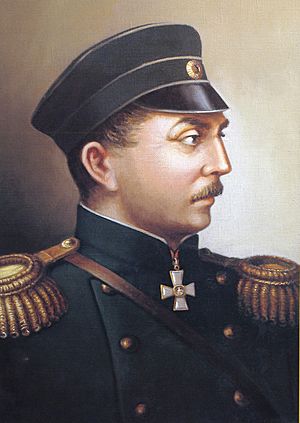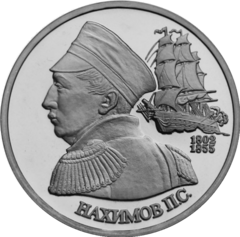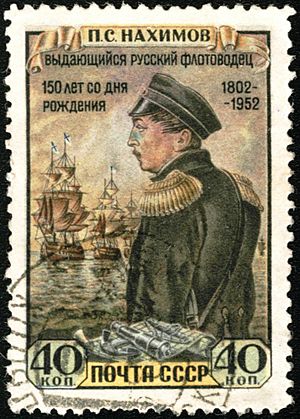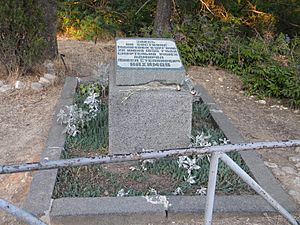Pavel Nakhimov facts for kids
Quick facts for kids
Pavel Nakhimov
|
|
|---|---|
 |
|
| Born | 5 July 1802 Vyazma uyezd, Smolensk Governorate, Russian Empire (Russia) |
| Died | 12 July 1855 (aged 53) Sevastopol, Taurida Governorate, (Crimea) |
| Buried | |
| Allegiance | |
| Service/ |
|
| Years of service | 1818–1855 |
| Rank | Admiral |
| Commands held | Corvette Navarine Frigate Pallada Ship of the line Silistria Ship Brigade of the Black Sea Fleet Chief of Fleet Division Squadron of the Black Sea Fleet Commander of Fleet and Port |
| Battles/wars | |
| Awards | see awards |
Pavel Stepanovich Nakhimov (born July 5, 1802 – died July 12, 1855) was a famous Russian Admiral. He was part of the Imperial Russian Navy. He is best known for his big victory in the Battle of Sinop. He also showed great leadership during the Siege of Sevastopol (1854–1855). Both of these events happened during the Crimean War.
Nakhimov joined the Russian Navy and quickly moved up in rank. He served in the Greek War of Independence and the Russo-Turkish War (1828–29). When the Crimean War began, he led his fleet to a major win against the Ottoman Empire at the Battle of Sinop.
Later, he became a key leader in defending the city of Sevastopol. This city was attacked by forces from Britain, France, and the Ottoman Empire. During this defense, a sniper shot him. He sadly died a few days later.
After his death, Pavel Nakhimov became a national hero in Russia. Many medals and ships were named after him. This was especially true during the Soviet era, starting with Joseph Stalin. A Soviet movie about his life, called Admiral Nakhimov, was made in 1947.
Contents
Pavel's Early Life
Pavel Nakhimov was born in a village called Gorodok. This village was in the Smolensk Governorate of Russia. His family was part of the Russian nobility, which meant they were from a high social class. He was the seventh of eleven children. His father, Stepan Mikhailovich Nakhimov, was a landlord and a military officer. His mother was Feodosia Ivanovna Nakhimova.
Sadly, six of his brothers and sisters died when they were babies. Pavel and his four surviving brothers all became professional sailors. One of his brothers, Sergei Stepanovich Nakhimov, also became a high-ranking naval officer.
In 1817, Pavel Nakhimov joined the Naval Academy for the Nobility in Saint Petersburg. This was a special school for young people from noble families who wanted to join the navy. In his first year, he sailed on a ship called the Feniks (meaning "Phoenix"). They traveled to the coasts of Sweden and Denmark. Soon after, he was promoted to a non-commissioned officer.
In February 1818, he passed his exams and became a midshipman. This meant he was now a junior officer in the Russian Imperial Navy. He was immediately assigned to the Baltic Fleet.
At first, Nakhimov's experience was mostly in the Baltic Sea. He also made a longer trip from the White Sea port of Arkhangelsk to Kronstadt. Kronstadt was a major naval base near Saint Petersburg.
His big chance came in March 1822. He was assigned to a frigate (a type of warship) called Kreiser ("Cruiser"). This ship was part of a trip around the world. The expedition was led by a famous Russian explorer, Mikhail Petrovich Lazarev. Lazarev had already made several such long voyages.
During this three-year journey, Nakhimov was promoted to the rank of lieutenant. When the adventure ended, he received his first award, the Order of Saint Vladimir. After this, he returned to his home region of Smolensk. He was then assigned to a large warship called the Azov, which had 74 guns. The Azov made its first trip from Arkhangelsk to Kronstadt in the autumn of 1826.
In the summer of 1827, the Azov sailed to the Mediterranean Sea. It was the main ship of the Russian fleet. They joined with the French and British navies to fight against the Ottoman Empire. Before they left, Emperor Nicholas I visited the Azov. He told the crew to fight the enemy "as the Russians do" if there was a battle.
The Azov, led by Captain First Rank Mikhail Petrovich Lazarev, fought bravely in the Battle of Navarino. This battle happened on October 20, 1827. The combined British, French, and Russian fleets completely destroyed the Ottoman fleet. Nakhimov, who was 27 years old, showed excellent skill with the ship's guns. Because of his great performance, he was promoted to captain of a captured enemy ship. He also received awards from the allied governments.
The Crimean War and His Last Battle
The Big Battle of Sinop
During the Crimean War (1853-1856), Nakhimov became famous for his victory against the Ottoman fleet at Sinope in 1853.
Before this battle, the Russian fleet in the Black Sea was split into two groups. One group was led by Nakhimov. The other was led by V. A. Kornilov. Nakhimov was in charge of the eastern part of the sea. The Ottomans knew the Russian forces were at sea. But they stayed in port, perhaps because they were afraid to fight Russia in the open sea.
Nakhimov asked for more ships, and he got them on November 27, 1853. A group of ships led by Admiral Fyodor Mihailovich Novosilskiy joined him. By the time of the battle, Nakhimov had six battleships, two frigates, and three steamships. The Russians had more powerful weapons, including new Paixhans guns.
On November 30, 1853, Nakhimov's fleet entered the bay where the Ottoman fleet was. The Ottoman fleet was led by Admiral Osman Pasha. First, the Russian fleet demanded that the Ottomans surrender. When the Ottomans refused, a fierce battle began.
At first, the Ottoman ships fought well. But the battle quickly turned in favor of the Russians. The powerful Russian guns were too much for the Ottomans. In just a few hours, most of the Ottoman fleet was on fire. One Ottoman ship, the Ottoman frigate Taif, managed to escape and sail to Istanbul. The Russians tried to catch it, but they couldn't. Even Admiral V. A. Kornilov, who arrived with more ships, could not capture it. The Taif reached Istanbul on December 2. It brought the news of Nakhimov's big victory.
During the battle, all the Ottoman ships, except for the Taif, were destroyed. Many Ottoman sailors died. Only about 33 to 36 Russian sailors and one officer died. Admiral Osman was wounded and captured, along with four other officers. They remained prisoners of war until 1855.
Nakhimov kept firing during the battle, even after most Ottoman ships were burning. This caused parts of the city of Sinop to catch fire. The city's leaders and many people living there fled. Some people criticized Nakhimov for this. However, he later explained that his goal was to "destroy the Ottoman fleet."
Defending Sevastopol
Nakhimov's most famous moment came during the Siege of Sevastopol. Here, he and Admiral V. A. Kornilov worked together. They organized the land defense of the city and its port from scratch. This port was the main base for the Russian Black Sea Fleet.
As the commander of the port and the military governor of the city, Nakhimov became the leader of all the naval and land defense forces in Sevastopol. On July 10, 1855, he was inspecting the front-line defense positions on Malakhov Kurgan. A sniper shot him, and he was badly wounded. He died two days later, on July 12, 1855.
His Legacy
Becoming a Hero
After his death, Pavel Nakhimov became a greatly admired figure. He was part of the "Sevastopol myth." This was a movement in Russia that celebrated the heroic defense of the city. Writers like Leo Tolstoy helped to spread this idea. In many writings, Nakhimov was shown as a "friend of the common people." He was called "the soul of the defense of Sevastopol."
Even though he was very popular with the public, the government at the time did not always fully recognize him. For example, the government asked artists painting a famous picture, "Defense of Sevastopol, 1854-5," to remove Nakhimov's image. They wanted him replaced with Mikhail Dmitrievich Gorchakov.
However, Nakhimov was later honored in the Soviet Union. During World War II, Soviet leaders like Joseph Stalin made Nakhimov a national hero. He was honored alongside other great Russian figures like Prince Pyotr Bagration, Mikhail Kutuzov, Aleksandr Nevsky, and Aleksandr Suvorov.
Statues and Honors
Many statues and medals have been created to remember Pavel Nakhimov. In the 1890s, a statue of Nakhimov and Vladimir Alexeyevich Kornilov was placed in Sevastopol.
Nakhimov was buried inside St Vladimir's Cathedral in Sevastopol. Other naval heroes like Mikhail Lazarev, V.A. Kornilov, and Vladimir Istomin are also buried there. There is also a monument built in his memory.
The Soviet government also created honors for him after his death. In 1943, they started Nakhimov Naval Schools for teenagers. In 1944, they created the Order of Nakhimov (which had two levels) and the Nakhimov Medal for Navy personnel. The Order of Nakhimov was one of the highest military awards in the Soviet Union. It still exists today in the Russian Federation.
Ships Named After Him
Several ships have been named in honor of Admiral Nakhimov:
- Admiral Nakhimov, an armored cruiser from Russia.
- The original name of Chervona Ukraina, a light cruiser.
- Admiral Nakhimov, a cruiser of the Sverdlov class.
- Admiral Nakhimov, a Soviet passenger ship.
- Admiral Nakhimov, a Kresta II-class cruiser.
- Admiral Nakhimov (formerly Kalinin), a Kirov-class battlecruiser.
Awards and Recognitions

Pavel Nakhimov received many important awards during his career:
- Order of St. Vladimir, 4th class (1825) – for his voyage on the frigate Cruiser.
- Order of Saint George, 4th class (1827) – for his service in the Battle of Navarino.
- Order of St. Anna, 2nd class (1830).
- Order of St. Anna, 2nd class with the Imperial Crown (1837) – for his hard work and excellent service.
- Order of St. Vladimir, 3rd class (1842) – for his hard work and excellent service.
- Badge of distinction "For impeccable service" XXV years (1846) – for 25 years of perfect service.
- Order of St. Stanislaus, 1st class (1847).
- Order of St. Anna, 1st class (1849).
- Order of St. Anna, 1st class with the Imperial Crown (1851).
- Order of St. Vladimir, 2nd class (1853) – for successfully moving the 13th Division.
- Order of Saint George, 2nd class (1853) – for his victory at Sinope.
- Order of the White Eagle (Russia) (1855) – for his actions in the defense of Sevastopol.
- Order of the Bath (United Kingdom) – an award from the British government.
- Order of the Redeemer (Greece) – an award from the Greek government.
Images for kids
-
Pavel Nakhimov's grave in St. Vladimir's Cathedral, Sevastopol
More to Explore
- Admiral Nakhimov (film)
- Osman Pasha (naval officer)
- Vladimir Alexeyevich Kornilov
- Battle of Sinop
See also
 In Spanish: Pável Najímov para niños
In Spanish: Pável Najímov para niños







